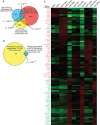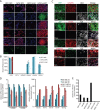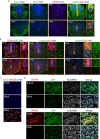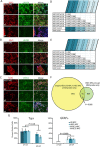Defining the nature of human pluripotent stem cell progeny
- PMID: 21844894
- PMCID: PMC3351932
- DOI: 10.1038/cr.2011.133
Defining the nature of human pluripotent stem cell progeny
Abstract
While it is clear that human pluripotent stem cells (hPSCs) can differentiate to generate a panoply of various cell types, it is unknown how closely in vitro development mirrors that which occurs in vivo. To determine whether human embryonic stem cells (hESCs) and human-induced pluripotent stem cells (hiPSCs) make equivalent progeny, and whether either makes cells that are analogous to tissue-derived cells, we performed comprehensive transcriptome profiling of purified PSC derivatives and their tissue-derived counterparts. Expression profiling demonstrated that hESCs and hiPSCs make nearly identical progeny for the neural, hepatic, and mesenchymal lineages, and an absence of re-expression from exogenous reprogramming factors in hiPSC progeny. However, when compared to a tissue-derived counterpart, the progeny of both hESCs and hiPSCs maintained expression of a subset of genes normally associated with early mammalian development, regardless of the type of cell generated. While pluripotent genes (OCT4, SOX2, REX1, and NANOG) appeared to be silenced immediately upon differentiation from hPSCs, genes normally unique to early embryos (LIN28A, LIN28B, DPPA4, and others) were not fully silenced in hPSC derivatives. These data and evidence from expression patterns in early human fetal tissue (3-16 weeks of development) suggest that the differentiated progeny of hPSCs are reflective of very early human development (< 6 weeks). These findings provide support for the idea that hPSCs can serve as useful in vitro models of early human development, but also raise important issues for disease modeling and the clinical application of hPSC derivatives.
Figures







Similar articles
-
High-efficiency generation of induced pluripotent mesenchymal stem cells from human dermal fibroblasts using recombinant proteins.Stem Cell Res Ther. 2016 Jul 30;7(1):99. doi: 10.1186/s13287-016-0358-4. Stem Cell Res Ther. 2016. PMID: 27473118 Free PMC article.
-
Culture conditions affect cardiac differentiation potential of human pluripotent stem cells.PLoS One. 2012;7(10):e48659. doi: 10.1371/journal.pone.0048659. Epub 2012 Oct 31. PLoS One. 2012. PMID: 23119085 Free PMC article.
-
Primed pluripotent cell lines derived from various embryonic origins and somatic cells in pig.PLoS One. 2013;8(1):e52481. doi: 10.1371/journal.pone.0052481. Epub 2013 Jan 11. PLoS One. 2013. PMID: 23326334 Free PMC article.
-
Sox2/Oct4: A delicately balanced partnership in pluripotent stem cells and embryogenesis.Biochim Biophys Acta. 2016 Jun;1859(6):780-91. doi: 10.1016/j.bbagrm.2016.03.006. Epub 2016 Mar 23. Biochim Biophys Acta. 2016. PMID: 26992828 Review.
-
Pluripotent genes in avian stem cells.Dev Growth Differ. 2013 Jan;55(1):41-51. doi: 10.1111/dgd.12021. Epub 2012 Dec 20. Dev Growth Differ. 2013. PMID: 23278808 Review.
Cited by
-
Changes in microRNA expression during differentiation of embryonic and induced pluripotent stem cells to definitive endoderm.Gene Expr Patterns. 2015 Sep-Nov;19(1-2):70-82. doi: 10.1016/j.gep.2015.08.001. Epub 2015 Aug 13. Gene Expr Patterns. 2015. PMID: 26277621 Free PMC article.
-
In vitro-differentiated neural cell cultures progress towards donor-identical brain tissue.Hum Mol Genet. 2013 Sep 1;22(17):3534-46. doi: 10.1093/hmg/ddt208. Epub 2013 May 10. Hum Mol Genet. 2013. PMID: 23666530 Free PMC article.
-
Human fetal tissue is critical for biomedical research.Stem Cell Reports. 2023 Dec 12;18(12):2300-2312. doi: 10.1016/j.stemcr.2023.10.008. Epub 2023 Nov 16. Stem Cell Reports. 2023. PMID: 37977142 Free PMC article. Review.
-
An analogue of the Prolactin Releasing Peptide reduces obesity and promotes adult neurogenesis.EMBO Rep. 2024 Jan;25(1):351-377. doi: 10.1038/s44319-023-00016-2. Epub 2023 Dec 20. EMBO Rep. 2024. PMID: 38177913 Free PMC article.
-
Advances and challenges in the differentiation of pluripotent stem cells into pancreatic β cells.World J Stem Cells. 2015 Jan 26;7(1):174-81. doi: 10.4252/wjsc.v7.i1.174. World J Stem Cells. 2015. PMID: 25621117 Free PMC article. Review.
References
-
- Takahashi K, Tanabe K, Ohnuki M, et al. Induction of pluripotent stem cells from adult human fibroblasts by defined factors. Cell. 2007;131:861–872. - PubMed
Publication types
MeSH terms
Substances
Grants and funding
LinkOut - more resources
Full Text Sources
Other Literature Sources
Research Materials

